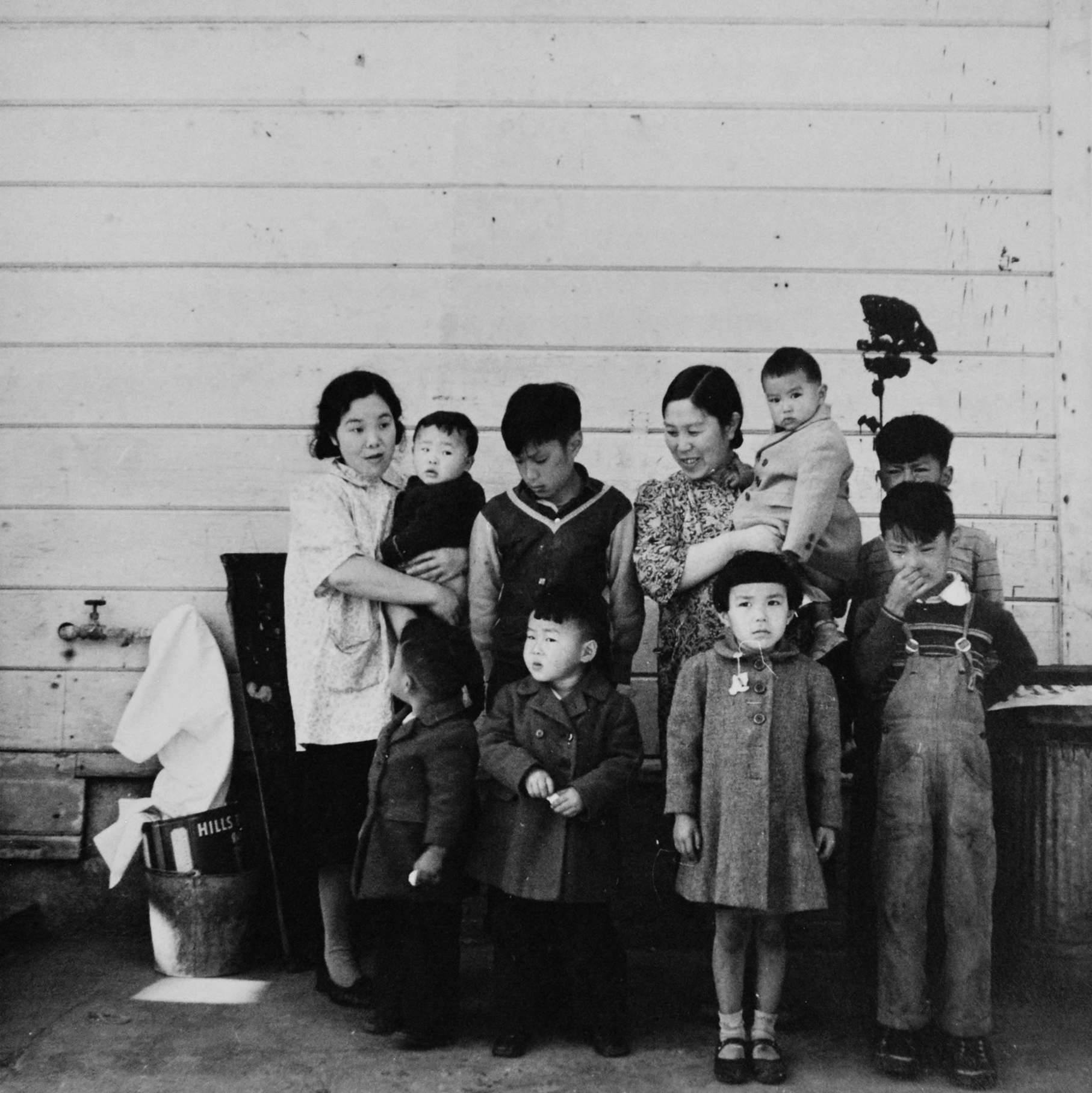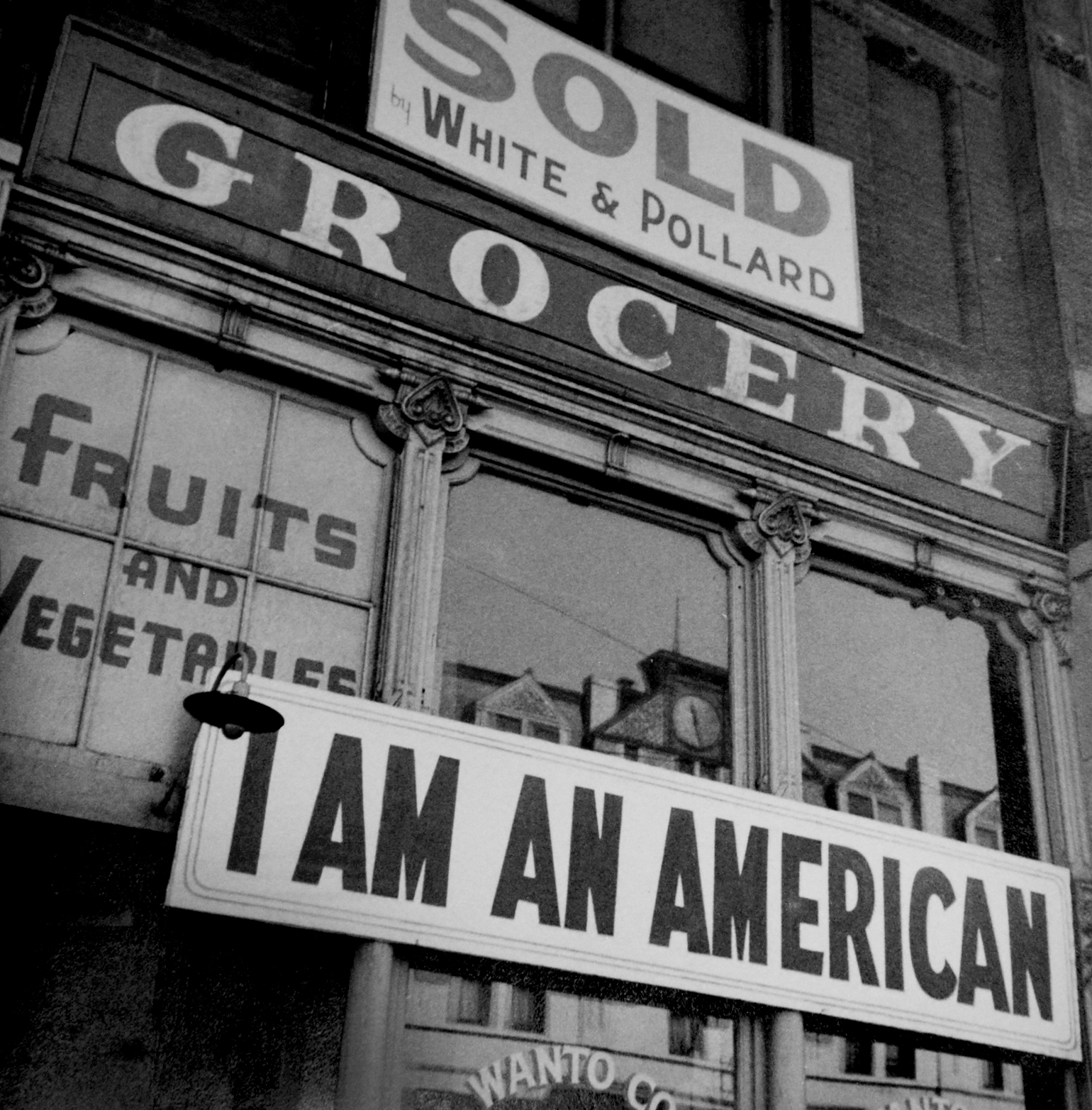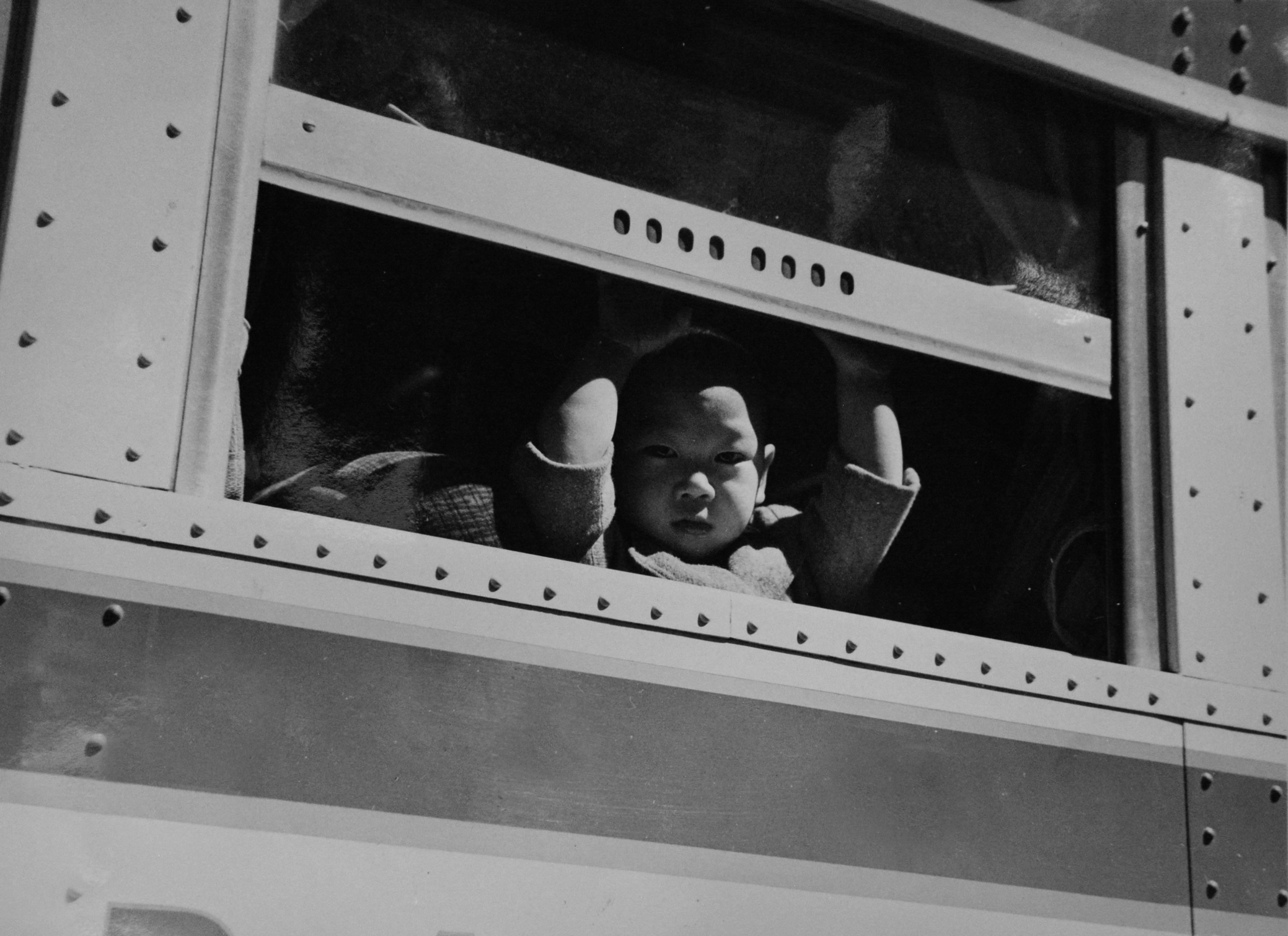FOR THE DURATION
Images By Dorothea Lange
February 26, 2018
Fig. 1. Florin, Sacramento County, California - May 11, 1942
A soldier and his mother in a strawberry field. This soldier, age 23, volunteered July 10, 1941 [5 months before Pearl Harbor], and is stationed at Camp Leonard Wood, Missouri. He was furloughed to help his mother and family prepare for their evacuation. He is the youngest of six children, two of them volunteers in the U.S. Army. The mother, age 52, came from Japan 37 years ago. Her husband died 21 years ago, leaving her to raise six children. She worked in a strawberry basket factory until last year when her children leased three acres of strawberries, “so she wouldn’t have to work for somebody else.” The family is Buddhist. This is her youngest son. Her second son is in the army stationed at Ft. Bliss. 453 families are to be evacuated from this area. No: [G2]A-585 – Dorothea Lange
_____________________________________________________________________
On February 19, 1942, Democratic President Franklin Delano Roosevelt signed and issued Presidential Executive Order 9066. This order would authorize the Secretary of War to establish military zones across the Western United States, with the largest in California, Colorado, and Wyoming. In the wake of Pearl Harbor, frenzied with bipartisan zeal, the United States Government incarcerated a majority of American Citizens with Japanese ancestry for the singular crime of having "a single drop of Japanese blood."
In April and May of 1942, a massive “evacuation” from Oakland, San Francisco, and the surrounding counties took place. Similar exoduses were occuring across the country, where tens of thousands of Americans were forced out of their homes, businesses, and lives. Similar in fashion to the "evacuations" taking place in Europe, with the Army’s Exclusion Order No. 20, California institutionalized the anti-Japanese sentiment that had been boiling for more than a half-century.
For most of these Californians, opposition to the Japanese was based upon fears where were largely non rational - It is instructive to note that these non rational fears were nowhere more persistent than in the minds of those middle-class leaders whom we have come to call progressive." - Roger Daniels, The Politics of Prejudice, p. 107
Experienced government photographer Dorothea Lange documented the activities leading up to, during, and after the evacuation in the wider Bay Area. Lange had worked for the Farm Security Administration (FSA) in the 1930s, documenting agricultural practices and conditions during the Dust Bowl that ravaged much of the country. Lange captured the iconic image Migrant Mother, an image that would codify the tenacity of the American migrant farmer of the 1930s for all time.
Lange had a particularly sensitive approach when documenting people, capturing only what the subject was inclined to offer. As Milton Meltzer writes in his biography of Lange:
Migrant Mother (1936) - Dorothea Lange
“She would never intrude her camera upon anyone’s privacy… If nothing was said but she felt unwelcome, she would fool around with her equipment or just go sit down in a corner and let them look her over. She was aware that some people withdrew because they felt she did not belong with them.
Tactfully then she would speak to them about who she was and what her family was like, where she came from, what she represented, so that she told them much about herself, and truthfully. Then if she asked questions, it was a fair exchange.” - Milton Meltzer Dorothea Lange: A Photographer’s Life, p. 97
This approach sharply contrasted that of Lange’s famous contemporary, Margret Bourke-White. American author and art critic William Stott wrote of Bourke-White that she “made her subjects’ faces and gestures say what she wanted them to. And what she wanted to say [was] blatant on every page.” Bourke-White's famous World’s Highest Standard of Living demonstrates her tendency toward the manipulation of her subjects in order to elicit a specific reaction. Where Bourke-White saw each subject as a means to her end, Lange built a practice around a genuine rapport with those she hoped to document. This allowed Lange to see a deeper and more authentic sense of what was, without inserting a preordained narrative.
The following images are public records of the War Relocation Authority (WRA), the government agency tasked with overseeing the evacuation orders. These records, and millions of others, are housed at the National Archives in College Park, Maryland, accessible to anyone with an afternoon at their disposal.
The following government records honestly depict an act that it willingly and energetically committed. I am thankful that an artist as compassionate, sensitive, and seeing as Dorothea Lange was there to honestly and accurately capture a tragic chapter of our shared history.
Lest we make the same mistakes again.
Fig. 2. San Francisco, California – April 7, 1942
While American troops were going in action on far-flung fronts, residents of Japanese ancestry were being evacuated from this neighborhood on Post Street. Evacuees will be housed in War Relocation Authority centers for the duration.
No: [G2]A-69 – Dorothea Lange
Fig. 3. San Francisco, California – April 23, 1942
In response to the Army’s Exclusion Order No. 20, residents of Japanese ancestry appear at Civil Control Station at 2031 Bush Street, for registration. The evacuees will be housed in War Relocation Authority centers for the duration.
No: [G2]A-514 – Dorothea Lange
Fig. 4. Centerville, California – May 9, 1942
Members of farm family await evacuation bus. In March they came from Santa Barbara County to Alameda County, so that all members of the family could be evacuated together. Evacuees of Japanese ancestry will be housed in War Relocation Authority centers for the duration.
No: [210-G2]C-226 – Dorothea Lange
Fig. 5. San Francisco, California – April 20, 1942
Waiting in line, 2031 Bush St., for voluntary inoculation against typhoid, preceding evacuation of residents of Japanese ancestry. Evacuees will be housed in War Relocation Authority centers for the duration.
No: [G2]A-570 – Dorothea Lange
Fig. 6. San Francisco, California – April 25, 1942
Residents of Japanese ancestry appear for registration prior to evacuation. Evacuees will be housed in War Relocation Authority centers for the duration.
No: [G2]A-572 – Dorothea Lange
Fig. 7. San Francisco (Bush Street), California – April 25, 1942
Families of two Shinto priests who were interred on December 8, 1941, immediately upon declaration of war. The mother at right has nine American-born children and has been in the United States ten years, and neither speak English. These evacuees and others will be leaving for the assembly center within a few days, and later transferred to WRA centers for the duration.
No: [G2]A-510 – Dorothea Lange
Fig. 8. San Francisco, California – April 13, 1942
Entrance to a restaurant vacated by a proprietor of Japanese descent prior to evacuation. Evacuees of Japanese ancestry will be housed in War Relocation Authority centers for the duration.
No: [G2]A-42 – Dorothea Lange
Fig. 9. San Francisco, California – April, 1942
A home is sought for kittens as owners prepare to evacuate. Evacuees of Japanese ancestry will be housed in War Relocation Authority centers for the duration.
No: [G2]A-580 – Dorothea Lange
Fig. 10. San Francisco, California (Post Street) – April 16, 1942
Everywhere in the Japanese quarter are evidence of the coming evacuation. This is a Laundry and Cleaning business which is just winding up its affairs prior to evacuation.
No: [210-G2]C-517 – Dorothea Lange
Fig. 11. Oakland, California – March 3, 1942
Following evacuation orders, this store, at 13th and Franklin Streets, was closed. The owner, a University of California graduate of Japanese descent, placed the “I AM AN AMERICAN” sign on the store front on December 8, the day after Pearl Harbor. Evacuees of Japanese ancestry will be housed in War Relocation Authority centers for the duration.
No: 210-G-2A-35 – Dorothea Lange
Fig. 12. Hayward, California
Baggage of evacuees of Japanese ancestry ready to be loaded on moving van. Evacuees will be housed in War Relocation Authority centers for the duration.
No: [210-G-2]C-149 – Dorothea Lange
Fig. 13. San Francisco, California – April 7, 1942
The moving van backs up to the curb to load possessions of residents of Japanese ancestry who are being evacuated from this flat building on Post Street. Evacuees will be housed in War Relocation Authority centers for duration.
No: [G2]A-70 – Dorothea Lange
Fig. 14. San Francisco, California – April 29, 1942
High school boys, on balcony of Japanese American Citizens League at 2031 Bush Street, look down the sidewalk where friends boarded evacuation buses Evacuees of Japanese ancestry will be housed in War Relocation Authority centers for the duration.
No: [210-G2]C-115 – Dorothea Lange
Fig. 15. San Francisco, California – May 9, 1942
This youngster is awaiting evacuation bus. Evacuees of Japanese ancestry will be housed in War Relocation Authority centers for the duration.
No: [2]C-204 – Dorothea Lange
Fig. 16. San Francisco, California – April 25, 1942
Japanese family heads and persons living alone, form a line outside Civil Control station located in the Japanese American Citizens League Auditorium at 2031 Bush Street, to appear for “processing” in response to Civilian Exclusion Order No. 20.
No: [G2]A-531 – Dorothea Lange
Fig. 17. San Francisco, California (2020 Van Ness Ave.) – April 6, 1942
Young musician of Japanese ancestry plays his guitar at the WCCA station. He is a member of the first contingent of over 600 persons to be evacuated from San Francisco.
No: [210-G2]C-430 – Dorothea Lange
Fig. 18. San Francisco, California – April 6, 1942
An early comer arrives with personal effects at 2020 Van Ness Avenue as part of the contingent of 664 residents of Japanese ancestry, first to be evacuated from San Francisco on April 6, 1942. Evacuees will be housed in War Relocation Authority centers for the duration.
No: [210-G-2]C-430 – Dorothea Lange
Fig. 19. Hayward, California – May 8, 1942
A young member of an evacuee family awaiting evacuation bus. Evacuees of Japanese ancestry will be housed in War Relocation Authority centers for the duration.
No: [210-G-2]C-158 – Dorothea Lange
Fig. 20. Centerville, California – April 9, 1942
Stenographer for Japanese American Citizens League of Mt. Eden township. Helps the farmers of the vicinity to close out their affairs before evacuation.
No: [G-2]A-524 – Dorothea Lange
Fig. 21. Hayward, California – May 8, 1942
A young member of an evacuee family awaiting evacuation bus. Evacuees of Japanese ancestry will be housed in War Relocation Authority centers for the duration.
No: [210-G-2]C-159 – Dorothea Lange
Fig. 22. Centerville, California – May 9, 1942
This girl, who worked as a strawberry picker on an Alameda County farm, awaits evacuation bus. Evacuees of Japanese ancestry will be housed in War Relocation Authority centers for the duration.
No: [210-G-2]C-222 – Dorothea Lange
Fig. 23. Oakland, California – May 6, 1942
Kimiko Kitagaki, young evacuee guarding the family baggage prior to departure by bus in one-half hour for Tanforan Assembly Center. Her father was, until evacuation, in the cleaning and dyeing business.
No: [210-G-2]C-580 – Dorothea Lange
Fig. 24. Sacramento, California – May 20, 1942
Harvey Akio Itano, 29, 1942 graduate of the University of California, who received his B.S. degree in Chemistry with the highest scholastic record of all candidates for degrees. He was chosen by the Faculty as University Medalist of 1942. He could not attend commencement exercises as evacuation of all residents of Japanese ancestry was ordered previously.
No: [210-G-2]C-460 – Dorothea Lange
Fig. 25. San Francisco, California (2031 Bush St.) – April 25, 1942
Methodist Japanese minister who has come to the WCCA station with 17 male members of his congregation to make the request that these 17 families be permitted to travel on the bus to the assembly center together if possible. This request was granted.
No: [210-G-2]C-355 – Dorothea Lange
Fig. 26. Byron, California – May 2, 1942
These families of Japanese ancestry, evacuated from farms in Contra Costa County, board bus for assembly center at Turlock Fairgrounds, 65 miles away. Evacuees will be transported later from assembly points to War Relocation Authority centers where they will spend the duration.
No: C-107 – Dorothea Lange
Fig. 27. Byron, California – May 2, 1942
This family of Japanese ancestry, evacuated from farm in Contra Costa County, boards bus for assembly center at Turlock Fairgrounds, 65 miles away. Evacuees will be transported later from assembly points to War Relocation Authority centers where they will spend the duration.
No: [210-G-2]C-105 – Dorothea Lange
Fig. 28. San Francisco, California (2031 Bush Street) – April 29, 1942
The bus is being loaded to take a group of 321 persons from the Japanese quarter on this date to Tanforan Assembly Center. The youth on the left is Mr. Hi Korematsu, a graduate of the College of Agriculture, Cornell University. He is a leader in formulating plans for the establishment of a large-scale cooperative enterprise for evacuated person of Japanese ancestry.
No: [210-G-2]C-415 – Dorothea Lange
Fig. 29. San Francisco, California – April 29, 1942
A young evacuee looks out the window of bus before it stars for Tanforan Assembly Center. Evacuees will be transferred later from assembly centers to War Relocation Authority centers where they will spend the duration.
No: [210-G-2]C-177 – Dorothea Lange
Fig. 30. Heyward, California – May 8, 1942
Members of the Mochida family awaiting evacuation bus. Identification tags are used to aid in keeping the family unit intact during all phases of evacuation. Mochida operated a nursery and five greenhouses on a two-acre site in Eden Township. He raised snapdragons and sweetpeas. Evacuees of Japanese ancestry will be housed in War Relocation Authority centers for the duration.
No: [210-G-2]C-153 – Dorothea Lange
Fig. 31. Heyward, California – May 8, 1942
Two children of the Mochida family who, with their parents, are awaiting evacuation bus. The youngster on the right holds a sandwich given her by one of a group of women who were present from a local church. The family unit is kept intact during evacuation and at War Relocation Authority centers where evacuees of Japanese ancestry will be housed for the duration.
No: [210-G-2]C-154 – Dorothea Lange
Fig. 32. San Francisco, California – April 20, 1942
As a safeguard for health, evacuees of Japanese descent were inoculated as they registered for evacuation at 2031 Bush Street. Nurses and doctors, also of Japanese ancestry, administered inoculations. Children were given special attention. Evacuees were later transferred to War Relocation Authority centers for the duration.
No: [G-2]A-504 – Dorothea Lange
Fig. 33. Oakland, California (1117 Oak Street) – May 6, 1942
Residents of Japanese ancestry waiting for evacuation buses which will take them to the Tanforan Assembly Center under Civilian Exclusion Order No. 28.
No: [210-G-2]C-374 – Dorothea Lange
Fig. 34. Byron, California – May 2, 1942
As families of Japanese ancestry evacuated from farms in Contra Costa County, they gathered at Wartime Civil Control Administration station and awaited buses for assembly center at Turlock Fairgrounds, 65 miles away. Evacuees will be transferred later from assembly centers to War Relocation Authority centers where they will spend the duration. Boy in background is a spectator.
No: [G-2]C-100 – Dorothea Lange







![Fig. 6. San Francisco, California – April 25, 1942Residents of Japanese ancestry appear for registration prior to evacuation. Evacuees will be housed in War Relocation Authority centers for the duration.No: [G2]A-572 – Dorothea Lange](https://images.squarespace-cdn.com/content/v1/5a5d3be40abd0443adf2a10a/1519590946421-68SVJDIXJUTT8AZYS2SP/7EDSC_2706.jpg)

![Fig. 8. San Francisco, California – April 13, 1942Entrance to a restaurant vacated by a proprietor of Japanese descent prior to evacuation. Evacuees of Japanese ancestry will be housed in War Relocation Authority centers for the duration.No: [G2]A-4…](https://images.squarespace-cdn.com/content/v1/5a5d3be40abd0443adf2a10a/1519591092317-6O6YESQEHVPBDMUBFN2D/1EDSC_2674.jpg)

![Fig. 9. San Francisco, California – April, 1942A home is sought for kittens as owners prepare to evacuate. Evacuees of Japanese ancestry will be housed in War Relocation Authority centers for the duration.No: [G2]A-580 – Dorothea Lange](https://images.squarespace-cdn.com/content/v1/5a5d3be40abd0443adf2a10a/1519591126712-VI6LN7ESGGY9FTBK80H0/3EDSC_2708.jpg)
![Fig. 10. San Francisco, California (Post Street) – April 16, 1942Everywhere in the Japanese quarter are evidence of the coming evacuation. This is a Laundry and Cleaning business which is just winding up its affairs prior to evacuation.No: [210-G2]C…](https://images.squarespace-cdn.com/content/v1/5a5d3be40abd0443adf2a10a/1519591194192-UX319G7P4I6SADLTT26F/5EDSC_2767.jpg)

![Fig. 12. Hayward, CaliforniaBaggage of evacuees of Japanese ancestry ready to be loaded on moving van. Evacuees will be housed in War Relocation Authority centers for the duration.No: [210-G-2]C-149 – Dorothea Lange](https://images.squarespace-cdn.com/content/v1/5a5d3be40abd0443adf2a10a/1519591270254-MIZV7EG7QJUOK6WNZE3M/9EDSC_2726.jpg)



![Fig. 15. San Francisco, California – May 9, 1942This youngster is awaiting evacuation bus. Evacuees of Japanese ancestry will be housed in War Relocation Authority centers for the duration.No: [2]C-204 – Dorothea Lange](https://images.squarespace-cdn.com/content/v1/5a5d3be40abd0443adf2a10a/1519591411806-BV7NTHE7BW9S4USSWVCO/5EDSC_2749.jpg)




![Fig. 19. Hayward, California – May 8, 1942A young member of an evacuee family awaiting evacuation bus. Evacuees of Japanese ancestry will be housed in War Relocation Authority centers for the duration.No: [210-G-2]C-158 – Dorothea Lange](https://images.squarespace-cdn.com/content/v1/5a5d3be40abd0443adf2a10a/1519591525911-Z4SN1LA37FAMEMAW0RK3/1EDSC_2734.jpg)
![Fig. 20. Centerville, California – April 9, 1942Stenographer for Japanese American Citizens League of Mt. Eden township. Helps the farmers of the vicinity to close out their affairs before evacuation.No: [G-2]A-524 – Dorothea Lange](https://images.squarespace-cdn.com/content/v1/5a5d3be40abd0443adf2a10a/1519591543233-M0TAF4MNAY9C7AO1UXMY/3EDSC_2696.jpg)
![Fig. 21. Hayward, California – May 8, 1942A young member of an evacuee family awaiting evacuation bus. Evacuees of Japanese ancestry will be housed in War Relocation Authority centers for the duration.No: [210-G-2]C-159 – Dorothea Lange](https://images.squarespace-cdn.com/content/v1/5a5d3be40abd0443adf2a10a/1519591557708-HFPNVUCP7W2IFF4SSN4R/5EDSC_2736.jpg)














![Fig. 33. Oakland, California (1117 Oak Street) – May 6, 1942Residents of Japanese ancestry waiting for evacuation buses which will take them to the Tanforan Assembly Center under Civilian Exclusion Order No. 28.No: [210-G-2]C-374 – Dorothea Lange](https://images.squarespace-cdn.com/content/v1/5a5d3be40abd0443adf2a10a/1519592113991-50IQ5DWE8VQE2QGIZMZG/7EDSC_2757.jpg)

